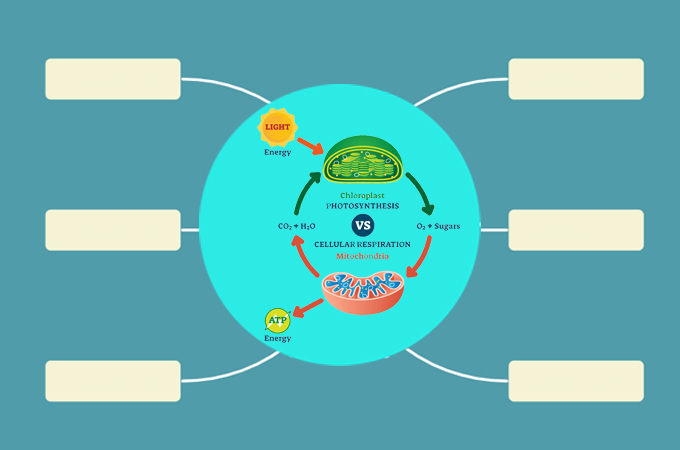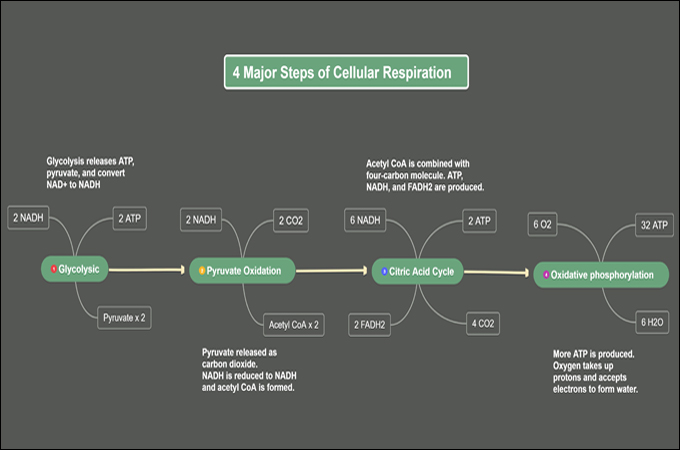
Cellular respiration is a chemical reaction present in all living organisms by which the cells convert sugar or glucose into energy. Meanwhile, this process produces the energy ATP. It is the main product of cellular respiration which sends fuel to various parts of the cell to make cellular activities. With cellular respiration, you can move around, lift weights, or do anything that needs energy. We will explain more about this fascinating chemical process and provide a comprehensive illustration using the biology cellular respiration concept map.
Cellular Respiration Concept Map Templates
- What is Cellular Respiration?
- Main Types Of Cellular Respiration
- Major Steps Of Cellular Respiration
- Stages Of Cellular Respiration and Where they occur
What is Cellular Respiration?

The process of energy consumption and use is called cellular respiration. Living organisms harvests energy from food molecules. In fact, it’s present inside the human body, plants, animals, and even fungi. Aside from that, cellular respiration is a process of breaking down sugar and other food molecules in the presence of oxygen. It helps to produce carbon dioxide, water, and ATP. ATP is the energy currency that every energy-dependent cellular function needs. Above is a simple cellular respiration concept map illustration.
Main Types Of Cellular Respiration

There are two main types of respiration: Aerobic respiration and Anaerobic respiration. We will discuss it here and explain it with a respiration concept map. The most common type of respiration is Aerobic. This respiration usually occurs in the presence of oxygen. Living organisms use oxygen to breakdown glucose and produce energy. Through this, an organism produces carbon dioxide and water. Whereas Anaerobic respiration proceeds without oxygen. With it, the organism still converts glucose to energy. But instead of carbon dioxide and water, lactic acid is built up. Make yourself familiar with the types of cellular respiration by looking at the biology cellular respiration concept map.
Major Steps Of Cellular Respiration

Cellular respiration involves four main steps in converting glucose molecules to harvest energy in one’s body cells. These are:
1. Glycolysis– The glucose undergoes chemical processes where it gets converted into pyruvate. The energy released in these reactions is ATP. Also, NAD+ is converted into NADH.
2. Pyruvate Oxidation– This is where pyruvate enters the mitochondrial matrix. The pyruvate will undergo series of steps and converted into acetyl CoA. A cellular respiration concept map will help you make understand this process better.
3. Citric Acid Cycle- The acetyl CoA goes through a cycle of reactions. Carbon dioxide is also released and ATP, NADH, and FADH2 are produced. We also provided a cell respiration concept map to visualize the process.
4. Oxidative phosphorylation- The process of transforming NADH or FADH2 to O2 to make ATP through series of electron carriers.
Stages Of Cellular Respiration and Where they occur
Cellular respiration undergoes three stages. Each stage takes place in different materials within a cell. This includes glycolysis, Krebs cycle, and electron transport.

1. Glycolysis- This is where glycolysis occurs in the cytoplasm of the cell. It splits molecules of glucose into smaller molecules known as pyruvate with the help of enzymes. As a result, two molecules of ATP will be produced. The best way to explain this is through a biology cellular respiration concept map above.
2. Krebs cycle- The second stage happens in the matrix of the mitochondrion. That’s where the pyruvate molecules enter to produce ATP. This stage produces energy-storing molecules that will help in making more ATP as stage 3 arrives. While the first stage does not require oxygen Krebs cycle requires oxygen to function.
3. Electron transport- The energy from the previous stages is used to produce more ATP. Over 34 ATP molecules are produced in this stage. For a comprehensive comparison, you can refer to the cell respiration concept map.
Conclusion
Cellular respiration is one of the most important reactions to learn about. It’s fascinating how living organisms produce energy from food. With the content above, you’ll learn about respiration at a high level with cellular respiration concept map illustrations to understand the subject matter better.
Leave a Comment